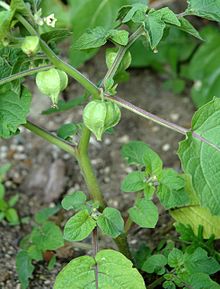46:
33:
210:, the fruit becomes edible (and sweet) once it has ripened to yellow. (The papery husk, a calyx, remains toxic and should not be eaten.) The fruit's flavor is similar in some respects to that of a ripe tomatillo, but notably has a strong flavor of pineapple as well, a fact reflected in the name of a common commercial variety, "Cossack Pineapple". The ripe fruit of
202:, often referred to as ground cherry or husk tomato. It is a native species in a range extending from northern Mexico through Central America. The plant has a low, spreading habit, and fruits develop in a papery husk, as is characteristic of the genus. While most parts of the plant are toxic to humans due to the presence of
272:
332:
509:
548:
224:
It is currently the subject of research into the possibility of developing a genetically modified variety for industrialized agriculture. The research involves
674:
457:
522:
470:
496:
527:
320:"This Wild Plant Could Be the Next Strawberry", Research News release, Howard Hughes Medical Institute, October 1, 2018
418:
405:
659:
600:
553:
669:
45:
605:
358:
423:
396:
574:
475:
248:
229:
162:
626:
40:
319:
579:
540:
514:
654:
561:
431:
302:
664:
566:
292:
284:
83:
592:
32:
587:
70:
648:
535:
260:
Ground Cherry
Ripeness, answers from a Hennepin County Master Gardener, July 13, 2019
178:
273:"Ethnobotany of the Genus Physalis L. (Solanaceae) in the South American Gran Chaco"
631:
436:
410:
483:
390:
207:
199:
129:
381:
306:
259:
444:
119:
618:
218:
613:
375:
288:
203:
194:
139:
109:
96:
462:
333:"Meet The Weird Fruit That Could Soon Become as Common as a Strawberry"
488:
297:
225:
352:
501:
449:
57:
356:
271:
Arenas, Pastor; Kamienkowski, Nicolás Martín (December 2013).
365:
8:
353:
31:
20:
296:
241:
7:
249:USDA National Plant Germplasm System
230:accelerate the domestication process
228:genome editing which may be able to
675:Crops originating from the Americas
14:
606:urn:lsid:ipni.org:names:317701-2
212:Physalis pruinosa var. argentina
44:
1:
691:
215:J. M. Toledo & Barboza
16:Species of flowering plant
217:is a food source for the
198:in the nightshade family
168:
161:
41:Scientific classification
39:
30:
23:
192:is a plant in the genus
575:Paleobiology Database
289:10.15553/c2012v682a9
660:Edible Solanaceae
642:
641:
562:Open Tree of Life
397:Physalis pruinosa
367:Physalis pruinosa
359:Taxon identifiers
331:Dockrill, Peter.
216:
189:Physalis pruinosa
185:
184:
172:Physalis pruinosa
25:Physalis pruinosa
682:
670:Fruit vegetables
635:
634:
622:
621:
609:
608:
596:
595:
583:
582:
570:
569:
557:
556:
544:
543:
531:
530:
518:
517:
505:
504:
492:
491:
479:
478:
466:
465:
453:
452:
440:
439:
427:
426:
414:
413:
401:
400:
399:
386:
385:
384:
354:
347:
346:
344:
343:
328:
322:
317:
311:
310:
300:
268:
262:
257:
251:
246:
214:
174:
154:P. pruinosa
49:
48:
35:
21:
690:
689:
685:
684:
683:
681:
680:
679:
645:
644:
643:
638:
630:
625:
617:
612:
604:
599:
591:
586:
578:
573:
565:
560:
552:
547:
539:
534:
526:
521:
513:
508:
500:
495:
487:
482:
474:
469:
461:
456:
448:
443:
435:
430:
422:
417:
409:
404:
395:
394:
389:
380:
379:
374:
361:
351:
350:
341:
339:
330:
329:
325:
318:
314:
270:
269:
265:
258:
254:
247:
243:
238:
181:
176:
170:
157:
43:
17:
12:
11:
5:
688:
686:
678:
677:
672:
667:
662:
657:
647:
646:
640:
639:
637:
636:
632:wfo-0001024921
623:
610:
597:
584:
571:
558:
545:
532:
519:
506:
493:
480:
467:
454:
441:
428:
415:
402:
387:
371:
369:
363:
362:
357:
349:
348:
323:
312:
283:(2): 251–266.
263:
252:
240:
239:
237:
234:
221:ethnic group.
183:
182:
177:
166:
165:
159:
158:
151:
149:
145:
144:
137:
133:
132:
127:
123:
122:
117:
113:
112:
107:
100:
99:
94:
87:
86:
81:
74:
73:
68:
61:
60:
55:
51:
50:
37:
36:
28:
27:
15:
13:
10:
9:
6:
4:
3:
2:
687:
676:
673:
671:
668:
666:
663:
661:
658:
656:
653:
652:
650:
633:
628:
624:
620:
615:
611:
607:
602:
598:
594:
589:
585:
581:
576:
572:
568:
563:
559:
555:
550:
546:
542:
537:
533:
529:
524:
520:
516:
511:
507:
503:
498:
494:
490:
485:
481:
477:
472:
468:
464:
459:
455:
451:
446:
442:
438:
433:
429:
425:
420:
416:
412:
407:
403:
398:
392:
388:
383:
377:
373:
372:
370:
368:
364:
360:
355:
338:
334:
327:
324:
321:
316:
313:
308:
304:
299:
294:
290:
286:
282:
278:
274:
267:
264:
261:
256:
253:
250:
245:
242:
235:
233:
231:
227:
222:
220:
213:
209:
205:
201:
197:
196:
191:
190:
180:
175:
173:
167:
164:
163:Binomial name
160:
156:
155:
150:
147:
146:
143:
142:
138:
135:
134:
131:
128:
125:
124:
121:
118:
115:
114:
111:
108:
105:
102:
101:
98:
95:
92:
89:
88:
85:
82:
79:
76:
75:
72:
71:Tracheophytes
69:
66:
63:
62:
59:
56:
53:
52:
47:
42:
38:
34:
29:
26:
22:
19:
366:
340:. Retrieved
337:ScienceAlert
336:
326:
315:
280:
276:
266:
255:
244:
223:
211:
193:
188:
187:
186:
171:
169:
153:
152:
140:
103:
90:
77:
64:
24:
18:
593:kew-2549665
484:iNaturalist
391:Wikispecies
84:Angiosperms
649:Categories
588:Plant List
342:2018-10-02
298:11336/8358
236:References
208:solanidine
200:Solanaceae
130:Solanaceae
541:109716654
307:0373-2967
277:Candollea
148:Species:
120:Solanales
54:Kingdom:
655:Physalis
619:29603921
614:Tropicos
515:11305138
502:317701-2
376:Wikidata
204:solanine
195:Physalis
141:Physalis
126:Family:
110:Asterids
97:Eudicots
665:Berries
463:6402729
382:Q291100
136:Genus:
116:Order:
58:Plantae
567:364768
554:304161
528:504375
489:290762
476:318476
424:438739
411:191798
305:
226:CRISPR
219:Pilagá
580:97715
510:IRMNG
450:PHYPR
437:4HFK8
104:Clade
91:Clade
78:Clade
65:Clade
601:POWO
549:NCBI
536:IUCN
523:ITIS
497:IPNI
471:GRIN
458:GBIF
445:EPPO
419:BOLD
406:APNI
303:ISSN
206:and
627:WFO
432:CoL
293:hdl
285:doi
651::
629::
616::
603::
590::
577::
564::
551::
538::
525::
512::
499::
486::
473::
460::
447::
434::
421::
408::
393::
378::
335:.
301:.
291:.
281:68
279:.
275:.
232:.
179:L.
106::
93::
80::
67::
345:.
309:.
295::
287::
Text is available under the Creative Commons Attribution-ShareAlike License. Additional terms may apply.
